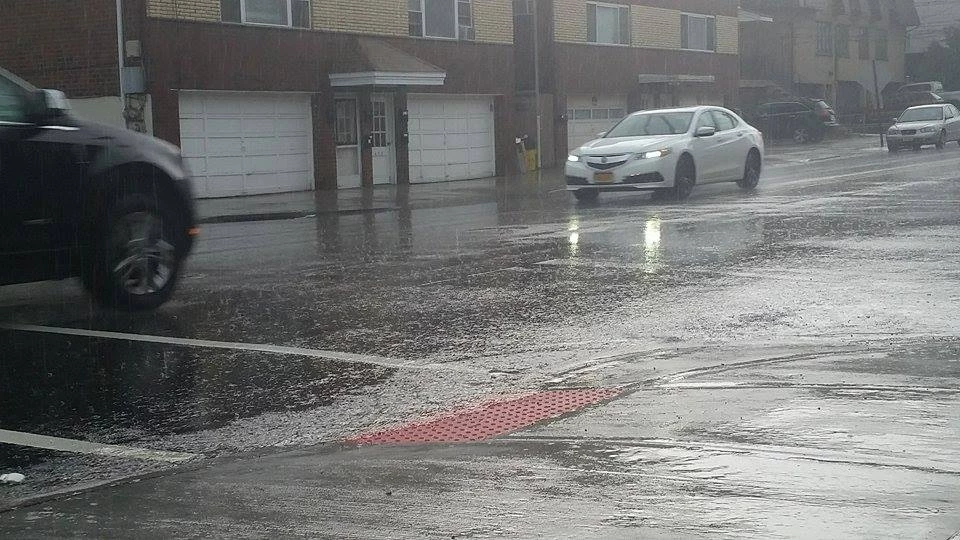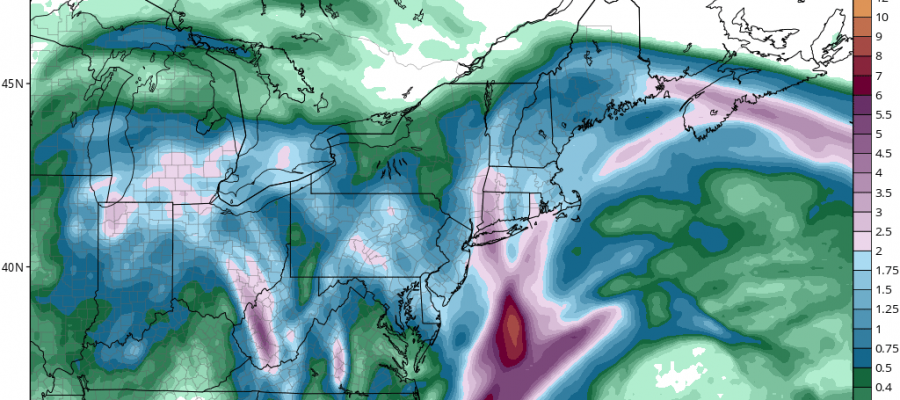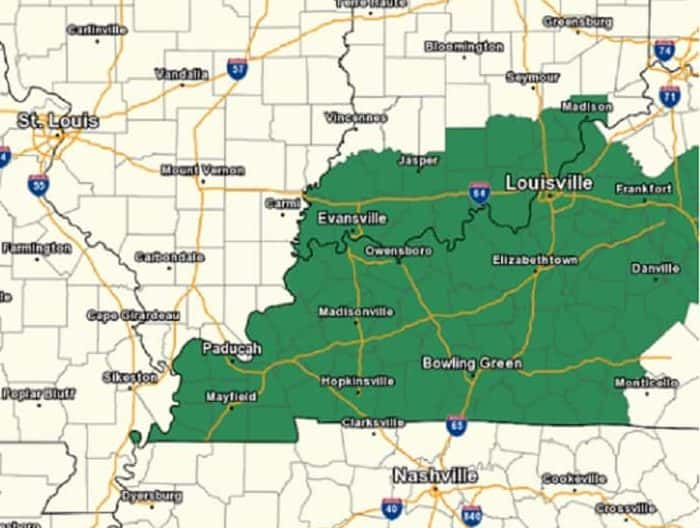A flash flood emergency was also issued for New York City and extended until 3 a.m. ET, according to the weather service, covering Manhattan, Queens, the Bronx and areas as far north as White Plains. The area has already seen between 2 and 3.5 inches of rain in just several hours and rainfall rates are expected to be as high as 3 to 5 inches an hour for the rest of Wednesday.
There are two types of alerts for flash floods which are issued by the National Weather Service. The weather service's Mount Holly office has already issued a flash flood watch for the 16 New Jersey counties it covers through 8 p.m. Higher amounts that could exceed 6 inches of rainfall are expected in parts of Hunterdon, Morris, Somerset and Warren counties. A flash flood emergency also was issued for Montgomery County, just north of Philadelphia, the National Weather Service said. Flash flooding has already begun Wednesday evening and more than 30 water rescues are taking place across the county, the weather service said.
The latest flash flood emergency included Newark, the state's largest city. Rainfall estimates for parts of central and eastern Pennsylvania and New Jersey ranged from 4 to 8 inches of water with some isolated locations approaching 10 inches. Some parts saw 3 to 4 inches of rain an hour throughout Wednesday evening. There are roughly 100,000 thunderstorms every year in the United States, and 1 in 10 is considered severe.
They cause flash floods, spark fires, and create hail, killing more people each year than do tornadoes, lightning, or hurricanes. Flash floods tear through dry waterbeds, city streets, and sewer drains at breakneck speed. But in developed urban areas, rain falls on impervious surfaces like sidewalks, parking lots, and driveways. Without land to absorb it, the water inundates roadways, culverts, and underpasses.Hail storms are expected to become more dangerous as the planet keeps overheating.
Researchers predict climate change will mean fewer days of hail ahead, but an increase in the size of hailstones, making them more destructive and more lethal. Some areas reported up to 10 inches of rain in less than an hour. Although the region was forecasted to experience heavy rains, this event is considered unprecedented as such a warning has never been issued to the area. The region had already experienced above average precipitation for most of the Summer due to previous storm systems and tropical storms affecting the area. Metro Birmingham remained under a flash flood watch, and meteorologists predicted another wet day for most of Alabama and parts of Florida, Georgia and Tennessee.
As much as 5 more inches of rain was possible through Thursday evening, the weather service said. Hoover rescuers have been searching Thursday for a couple believed to have been swept away in flood waters. (Photo/Carol Robinson for MCT) (Photo/Carol Robinson for MCT) Metro Birmingham remained under a flash flood watch, and meteorologists predicted another wet day for most of Alabama and parts of Florida, Georgia and Tennessee. Near the coast, heavy rains caused sewage to bubble out of underground pipes. This was 1.53" above the 1981–2010 average and ranked as the 32nd wettest since 1895. It was the wettest August since the record wettest month in 2011.
As is often seen in the summer, the majority of the precipitation fell in scattered showers and thunderstorms. This resulted in a wide range of monthly totals around the state, with some serious flash flooding occurring in several locations when moisture ladened storms parked themselves over an area for multiple hours. Where storms missed time and time again, rainfall totals were below average. The northern NJ climate division saw their 10th wettest August on record, with an average of 8.28" falling.
This was 0.35" below normal and ranks as the 52nd driest of the past 125 Augusts. As expected during a summer month that is dominated by hit and miss showers, rainfall totals varied quite a bit, even on a local scale. The driest location in the state was Lambertville in Hunterdon County where 1.48" fell, while the wettest was Lebanon, also in Hunterdon County, with 7.99". When and where the storms struck, they were, at times, intense. This included small tornadoes and more widespread strong winds, dangerous lightning, and flash flooding.
"Significant flooding and flash flooding is likely Wednesday and Wednesday night, especially given that the ground is saturated from recent heavy rain events," the weather service said. As much as 6 inches of rain fell in about a day as the low-pressure system lingered over Alabama and the Florida Panhandle. The forecast called for particularly intense rain Thursday in parts of metro Birmingham, which were under a flash flood watch, but meteorologists predicted another wet day for most of the state and parts of Florida. The FOX 5 Storm Team said about 1 to 2 inches of rain is likely by the end of the weekend with heavier amounts in extreme north Georgia. Parts of extreme north Georgia are under a Flash Flood Watch until midnight Monday.
A flash flood emergency was issued in Connecticut -- the first ever in the state -- with significant, life-threatening and unusual flash flooding expected. New York City also had its own first-ever flash flood emergency Wednesday, as historic amounts of rain fell, causing widespread flooding. Ida developed in the Caribbean, being named a tropical storm on August 26th. From there, it moved northwestward, attaining hurricane status on the 27th as it passed over extreme western Cuba and moved into the Gulf of Mexico.
It maintained a steady course as it strengthened into a major category 4 hurricane, making landfall in Louisiana on the 29th with sustained one-minute wind speeds as high as 150 mph. Once inland, winds diminished rather quickly but rainfall associated with the tempest remained heavy as the storm began to curve toward the northeast. This track remained quite steady as the storm weakened to a tropical depression on the 30th and became an extratropical low-pressure system as it approached the central Appalachians. On September 1st, Ida's remnants merged with an advancing cold front as the system entered the Mid-Atlantic and crossed New Jersey before moving into southeast New England on the 2nd. Ida made landfall in Louisiana on Sunday as a Category 4 hurricane, and though it has weakened significantly since, it has still dropped heavy rain across the Southeast on its way north. More than 60 million people are under flash flood watches for parts of the central Appalachians, mid-Atlantic, and into southern New York and southern New England.
The National Weather Service said law enforcement and emergency management in several districts reported flash flooding and road closures across the warned area. Up to two inches of rain have already fallen and flash flooding is already occurring. Many subway stops across NYC were flooded from the heavy rains. At 149th St. and Grand Concourse, storm water poured down the stairs. At the Court Square stop in Long Island City, rain from the storm grate showered the platform.
MTA officials say it invested heavily into improving drainage and pumping systems, proving the subways might be more resilient now to a tropical storm. It is always comforting to enter the water demand season, namely summer, with a bit of a hydrological cushion. Such is the case this year across NJ, thanks to ample rain and some late-season snow in recent months. This timely precipitation has eliminated drought concerns that stemmed from drier-than-normal intervals during 2016.
Aside from two reservoirs in west central NJ remaining below average, at the moment all other hydrological signs are positive. However, no one should let their guard down and fail to appreciate the finite nature of our fresh water resources, and how quickly a period of abundance can lapse again into drought. Post tropical storm Ida moved across the Garden State during the afternoon of September 1st into the early hours of the 2nd. It brought with it torrential rainfall, leading to flash and river flooding that took the lives of approximately 30 individuals and the rescue of countless more from raging waters. Additionally, it brought three tornadoes to southwestern and central areas, including the first EF-3 twister to strike New Jersey in 31 years.
There were only minor injuries and no deaths from the tornadoes. Following reports of an uncontrolled release from Pennsylvania's Wilmore Dam, causing flash flooding downstream of the dam, the National Weather Service issued a flash flood emergency -- the highest level of threat. Portions of western Monmouth County also remained under a flash flood warning. The weather service advised residents to seek higher ground and avoid walking through flood waters. BIRMINGHAM, Ala. – As much as 6 inches of rain fell in Alabama in about a day, unleashing flash floods that required some people to be rescued. Additional storms Wednesday brought the threat of twisters to the Southeast.
As much as 6 inches of rain fell in Alabama in about a day, unleashing flash floods that required some people to be rescued. Dozens of people had to be rescued, mostly from cars stranded in water. The severe storms were thanks to the remnants of Hurricane Delta. Delta stormed ashore late Friday as a Category 2 storm but has weakened significantly since.
Friday near Creole, Louisiana, with top winds of 100 mph before pushing inland. By Saturday afternoon, it was just a tropical depression but still pushed tropical moisture into Georgia which prompted the bout of severe weather. The severe storms might have moved out, but the threat of flash flooding continues across north Georgia. As of 9 p.m., a Flash Flood Warning was issued for Cobb, Clayton, DeKalb, Forsyth, Fulton, Gwinnett, and Rockdale counties until 4 a.m.
There also is aRiver Flood Warning for Cobb, DeKalb, Forsyth, Fulton, and Gwinnett counties. A flash flood warning was issued for Philadelphia, Pennsylvania, and nearby communities on Saturday, August 28, as a cold front brought showers and thunderstorms to parts of the northeast. The National Weather Service's forecast calls for more severe thunderstorms and heavy rain to continue through Thursday morning. The current storm system is connected to what is left of Hurricane Ida, which pounded areas of the south earlier this week.
The title of this month's report speaks to this momentous weather extreme that will forever be the defining event of this month and likely the entire year. The storm delivered the most powerful tornado to strike the Garden State since 1990, demolishing multiple homes in Gloucester County. Rainfall exceeding 3.00" per hour led to the most widespread flash flood event on record for the state, resulting in the tragic deaths of 30 individuals in central and northeastern locales. A separate report on Ida has been prepared and may be accessed in the "News" menu. Again, in the past there have been heavier rains, but the rate of rain is going to be tough to copy in the future for this part of the country. It's still a mess up there with numerous roads closed by flooding and billions of dollars in damage, adding up due to flooded out cars and homes/apartments etc.
Also, typically an excessive rain event of rates 3-4 inches per hour would affect a smaller area, like a county or two , but not a whole region like what happened in the New York City region. Most flash floods occur when there is a heavy amount of precipitation falling in an area and that water is then channeled through streams or narrow gullies. It is possible to experience a flash flood without witnessing any rain. Newark is also on watch for a possible flash flood with a range of 2 to 3 inches of rain. At Newark airport, flooding has caused an economy parking lot to close. There were also reports of wind gusts of 54 mph in Perth Amboy and 58 mph in Newark.
Parts of the Northeast, including New York, have been experiencing severe weather over the past few days. Flooding was reported in New York, Pennsylvania, New Jersey and other areas in recent days. States of emergency were declared in both New York and New Jersey on Tuesday following days of flash flooding, WABC-TV reported.
A flash flood watch covered most of Alabama and north Georgia, and forecasters issued flood warnings near a few rising creeks and rivers. Flash flooding in Mississippi typically is caused by sudden, heavy rain from slow-moving thunderstorms. Severe storms and a few isolated tornadoes from a slow-moving low pressure system were a threat, mainly in the afternoon, forecasters said.
The National Weather Service issued a tornado watch for northeastern Alabama, northwestern Georgia and southern Tennessee. Severe storms and a few isolated tornadoes from a slow-moving low-pressure system were a threat, mainly in the afternoon, forecasters said. Meteorologists predicted another wet day for most of Alabama and parts of Florida, Georgia and Tennessee.
There are predictions that three to six inches of rain will fall across New Jersey, with northern parts of the state – including Hunterdon, Morris, Somerset and Warren counties – expected to see higher rainfall totals. The National Weather Service issued a tornado watch for 15 New Jersey counties this afternoon along with expectations of thunderstorms, more rainfall, and gusty winds. In addition to all this there were so many different things happening. Tornado warnings and emergencies, severe thunderstorm warnings, flash flood emergencies, all for the same areas. New York issued its first flash flood emergencies for the city itself as well as northwest New Jersey. The National Weather Service upgraded its tropical storm watch to a tropical storm warning for most Atlantic, Burlington, Cape May, Monmouth and Ocean counties, where the highest wind gusts are expected.
At least five flash flood emergencies were issued Wednesday evening by the National Weather Service, stretching from just west of Philadelphia through northern New Jersey. Dozens of water rescues were taking place and numerous roads have been closed. The rain was so extreme in New York that, for the first time, National Weather Service issued a flash-flood emergency alert Wednesday night for the city, the warning reserved for the most dire rainfall conditions. It was later downgraded, and much of the area was still under a flood warning early Thursday. Ida finally became a tropical storm again 16 hours after making landfall. Its top sustained wind were 60 mph early Monday, and forecasters said it would rapidly weaken while still dumping torrential rain over a large area.
The storm was centered about 95 miles south-southwest of Jackson, Mississippi, moving north at 8 mph. Expect heavy rainfall, flash flooding, lightning, strong gusty winds, isolated tornadoes. Down trees, power lines and power outages are also possible. The Chrysler Building in New York City is seen through a rain covered high-rise window on August 13, 2018. A flash flood warning was issued for New York City on Tuesday.
More than 100 rescuers were involved in the effort, as were 16 boats, the statement said. With rainfall totals already ranging from 2 inches to as much 6 inches across the state this week, forecasters said another 3 inches of rain was possible, with the heaviest rains to the north. Tropical storm and flash flood warnings were issued for New York City, Long Island, New Jersey and across the Tri-State. Ida, now a tropical storm, is hitting on the 16-year anniversary of Katrina, a Category 3 hurricane that ravaged the Gulf Coast.
Hurricane Katrina unleashed a series of events, taking the lives of more than 1,800 people and leaving more than $100 billion worth of damage in its wake. Hamilton County, Ohio, which consists of the Cincinnati metropolitan area in southern Ohio, gets plenty of hail. Dozens of incidents were reported in 2020 by trained spotters in the region, which also issued severe weather warnings more than six dozen times in the same time period. Flash floods, which can happen with no warning, are common events in southern Nevada, the location of Clark County, which encompasses Las Vegas.
During flood season from July to September, moist air from the Gulf of Mexico is forced upward by hot air currents, causing severe thunderstorms. Hitting baked-dry desert surfaces, the rainwater can run off rapidly, filling underpasses, viaducts, and low roads in developed areas. Massachusetts' Middlesex County, which is essentially Boston, is prone to storms called nor'easters, which move up the Atlantic coast and blow in with powerful northeast winds. Depending on whether they arrive over land or water, nor'easters can bring torrential rain, flooding, heavy snow, and huge waves as well as thunder and lightning. Proximity to Lake Michigan means Cook County, which includes Chicago, gets unsettling severe weather known as training thunderstorms.
Unlike typical quick single-cell thunderstorms, training thunderstorms can repeatedly build in the same areas for hours and produce serious flooding. The name comes from the resemblance to train cars on railroad tracks. Weather is often a go-to conversation filler or ice-breaker.

























